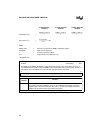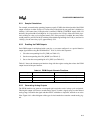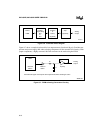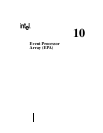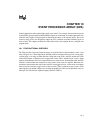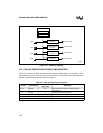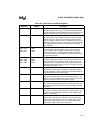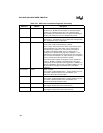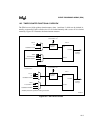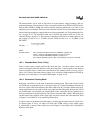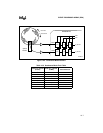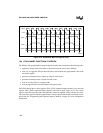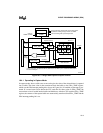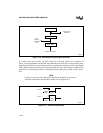
8XC196NP, 80C196NU USER’S MANUAL
10-4
P1_MODE 1FD0H Port 1
Mode
Each bit of P1_MODE controls whether the corresponding pin
functions as a standard I/O port pin or as a special-function
signal. Setting a bit configures a pin as a special-function signal;
clearing a bit configures a pin as a standard I/O port pin.
P1_PIN 1FD6H Port 1 Input
Each bit of P1_PIN reflects the current state of the corresponding
pin, regardless of the pin configuration.
P1_REG 1FD4H Port 1 Data Output
For an input, set the corresponding P1_REG bit.
For an output, write the data to be driven out by each pin to the
corresponding bit of P1_REG. When a pin is configured as
standard I/O (P1_MODE.
y
= 0), the result of a CPU write to
P
x
_REG is immediately visible on the pin. When a pin is
configured as a special-function signal (P1_MODE.
y
= 1), the
associated on-chip peripheral or off-chip component controls the
pin. The CPU can still write to P1_REG, but the pin is unaffected
until it is switched back to its standard I/O function.
This feature allows software to configure a pin as standard I/O
(clear P1_MODE.
y
), initialize or overwrite the pin value, then
configure the pin as a special-function signal (set P1_MODE.
y
). In
this way, initialization, fault recovery, exception handling, etc., can
be done without changing the operation of the associated
peripheral.
T1CONTROL 1F90H Timer 1 Control
This register enables/disables timer 1, controls whether it counts
up or down, selects the clock source and direction, and
determines the clock prescaler setting.
T2CONTROL 1F94H Timer 2 Control
This register enables/disables timer 2, controls whether it counts
up or down, selects the clock source and direction, and
determines the clock prescaler setting.
TIMER1 1F92H Timer 1 Value
This register contains the current value of timer 1.
TIMER2 1F96H Timer 2 Value
This register contains the current value of timer 2.
Table 10-2. EPA Control and Status Registers (Continued)
Mnemonic Address Description



